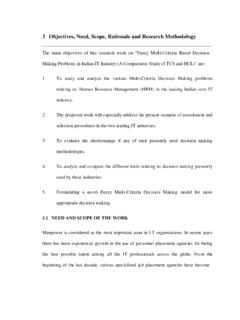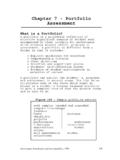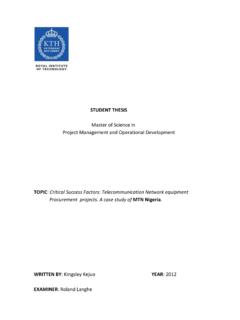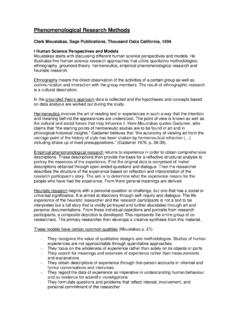Transcription of Investigating Investigation Methodologies
1 Investigating Investigation MethodologiesLudwig Benner Jr. Starline Software Ltd. Oakton Virginia 2003 by Ludwig Benner JrKeywords: Investigation , methodology, RCA, MESA bstractRecent years have seen an increase in the number of Investigation Methodologies . For example,today investigators can choose among Investigation Methodologies like ICAO, ISIM. MES, RootCause Analysis, Tripod-Beta, or TOR, to name a few. How do investigations and work productsproduced with these Investigation Methodologies compare?Several investigators have reported comparisons of Investigation Methodologies but criteria forcomparison, developed in different ways, have been inconsistent, leaving the question of theircomparative merits unresolved. This paper is a progress report of an inquiry to develop acomparison based on a desktop simulation of an Investigation with one methodology using datafrom a published accident report prepared with another methodology.
2 The work is disclosingsubstantial differences attributable to a methodology is a key Investigation program decision. What information is availableto support this decision? A recent paper by Sklet [1] presents a comparison of 14 differentmethods of Investigation , offering seven different characteristics by which the methods arecompared. Harvey [2] examined four accident Investigation models in terms of their ability tosatisfy five evaluation criteria representing his view of major purposes of accident author [3] ranked 17 Investigation models used by governmental organizations, using twelveassessment criteria. Henderson et al [4] reported five criteria for good investigations. TheCenter for Chemical Process Safety [5] published a list of 18 Investigation techniques withthree basic criteria. The criteria for the these comparisons were all developed seven characteristics for his comparison, derived from his expectations of theresults required, and presented a table summarizing the attributes of each method of investigationto help distinguish the differences and, by implication, the relative merit of the s criteria for comparing the four general Investigation models were derived from purposesof accident investigations.
3 He judges one model the best. In an earlier ranking of accidentinvestigation models Benner suggested 10 criteria for judging the merits of Investigation modelsof 17 organizations, derived from Investigation objectives; statutory mandates; organizations accident Investigation work products; interviews; and previous research discussions. Though theirreport did not focus on comparing Investigation methods, Henderson et al in their study ofinvestigation drivers, methods and outcomes offered criteria for good investigations derived fromsurveys The Center for Chemical Process Safety has published a comparison of 18 Investigation techniques with eighteen attributes noted for each. The attributes used are based on basicconcepts, degree of recognition, and areas of application. This prior work did not compare the Methodologies from the perspective of their effects oninvestigators specific tasks during investigations.
4 An obvious and probably the most persuasiveway to make such a comparison would be to conduct simultaneous investigations of the sameaccident using two or more different Methodologies , and compare the Investigation conduct andoutputs. The project would have to be designed carefully to minimize interference between thetwo investigations. Before expending resources required for such a project, it seemed reasonableto try to explore a less resource-intensive approach for the comparative evaluations, to see if itmight disclose approach: The approach devised was to use data from an accident report developed withone methodology as inputs to a desktop simulation of an Investigation with anothermethodology. Details about the methodology used or how they influenced the investigations tasksthat produced a report are not usually reported, except for special tasks like tests or simulations,for example.
5 However, it seems reasonable to assume that what is reported reflects the influenceof the methodology used on the Investigation and reportCase Selection: Because of its widespread use in the nuclear, chemical and medical fields, themethodology chosen for the data source is the Root Cause Analysis (RCA) methodology,represented by a report prepared with a variant of that methodology. The methodology chosen forthe desktop simulation, the Multilinear Events Sequencing based (MES) investigationmethodology. Both were analyzed in prior studiesThe case selected for this examination is described in a comprehensive accident report by theChemical Safety and Hazards Investigation Board. [6] It is the policy of the CSB to always do aroot cause analysis. An accident in a plastics manufacturing plant fatally injured three report of the Investigation contains a very extensive description of that accident process, theroot and contributing causes found, and recommendations to prevent similar the report does not identify the Investigation methodology used, the findings, the timeline, the analytical logic trees and language in the report reflect the key elements of RCA,indicating the Investigation methodology used was the Agency s variant of of Methodologies : RCA is an experience-oriented Investigation methodologyevolved from the U.
6 S. Navy s nuclear submarine program and MORT research performed for Atomic Energy Commission. [7] MES is a self-directing rule-oriented investigationmethodology, derived from observations of and experimentation with Investigation processes atthe NTSB and is a team Investigation process. Investigators require extensive training in the method,because its application is heavily experience oriented. After the team is formed, the investigatorsbegin acquiring data, using why questions, and use check lists, events and causal factors charts,logic trees, cause trees, and similar aids to identify and document the causal factors. After thecausal factors are developed, guides offering categories of basic or root causes are available tohelp investigators or analysts negotiate, select and report the basic or root and contributingcauses, and make recommendations.
7 The narrative report is prepared from these data andfindings. Narrative reports are usually accompanied by a chart, a timeline or logic tree to helpcommunicate the Investigation has many variants, but the variants have similar goals, and use many similar tools andprocedures. The goals are to determine root causes of accidents or occurrences that can be usedfor achieving future performance improvement. Another common goal is producingrecommendations about problems that management has control to fix, and when fixed willsignificantly reduce or prevent the problem s recurrence. [8] The RCA Investigation tools includeevents and causal factors charting, time lines, logic tree-based analyses like fault trees, and causalmaps or guides to help investigators. Some variants use specialized tools like fishbone diagrams,Why Staircases, change analysis, barrier analysis, and energy-barrier analysis.
8 RCA softwarepackages are available to implement several of the is a self-directing system of concepts, principles, rules and procedures for any kind ofinvestigation. [9,10] It focuses on identifying, describing, and explaining the behaviors andinteractions of people and objects during accidents, and on developing changes in those behaviorsthat can be implemented and tracked to achieve continuous improvement in future views the occurrence being investigated is a process, which can be flow-charted when it isadequately understood. Adapted from the structure and notations for documenting musical scores,MES uses a matrix-based structure with data documentation, organization and analysis tools andrules, plus continuing logic tests, to drive the Investigation tasks. Matrix entries follow prescribedgrammar and syntax rules of construction for event blocks on matrices including person, number,tense, voice and deictic position -- MES data language -- and reasoning rules to develop testeddescriptions and explanations of what happened.
9 MES then analyzes those descriptionssystematically with orderly sequential problem defining, change development and ranking tasksand rules. MES provides some generalized behavioral models, guiding principles and assessmentor ranking tools to convey knowledge from prior experiences to help investigators. Softwareimplementing MES and self-directing learning tools are simulation with the MES-based methodology started with the notification of the accident andcreation of an MES matrix, and continued with the acquisition of more data, guided by the dataalready recorded as event blocks on an expanding matrix. As data were needed, the report wasperused to find it and add it to the matrix. If the report did not provide needed data, gaps becamevisible on the matrix. These gaps were filled with inferred or hypothesized event blocks, and thereport was again scanned to find supporting data.
10 If it was not found, the matrix was marked witha "?" or e or dashed arrow or comment to highlight the gap. The evolving matrix guided theinvestigation Simulation Data Source: The 97 page CSB report contains data about the facility: itshistory and its operation; a diagram of the process equipment involved; a description and analysisof what happened; a description of some aspects of the Investigation , a discussion of relevantregulations; the three root causes and four contributing factors found; eleven recommendations; alist of seventeen literature references; a variant of an events and causal factors chart; and severallogic trees dealing with specific aspects of the accident. The report does not describe the conductof the Investigation , except in a few instances where it describes tasks related to acquisition ofspecific data like pressure estimates, so how specific tasks were performed is not known.






